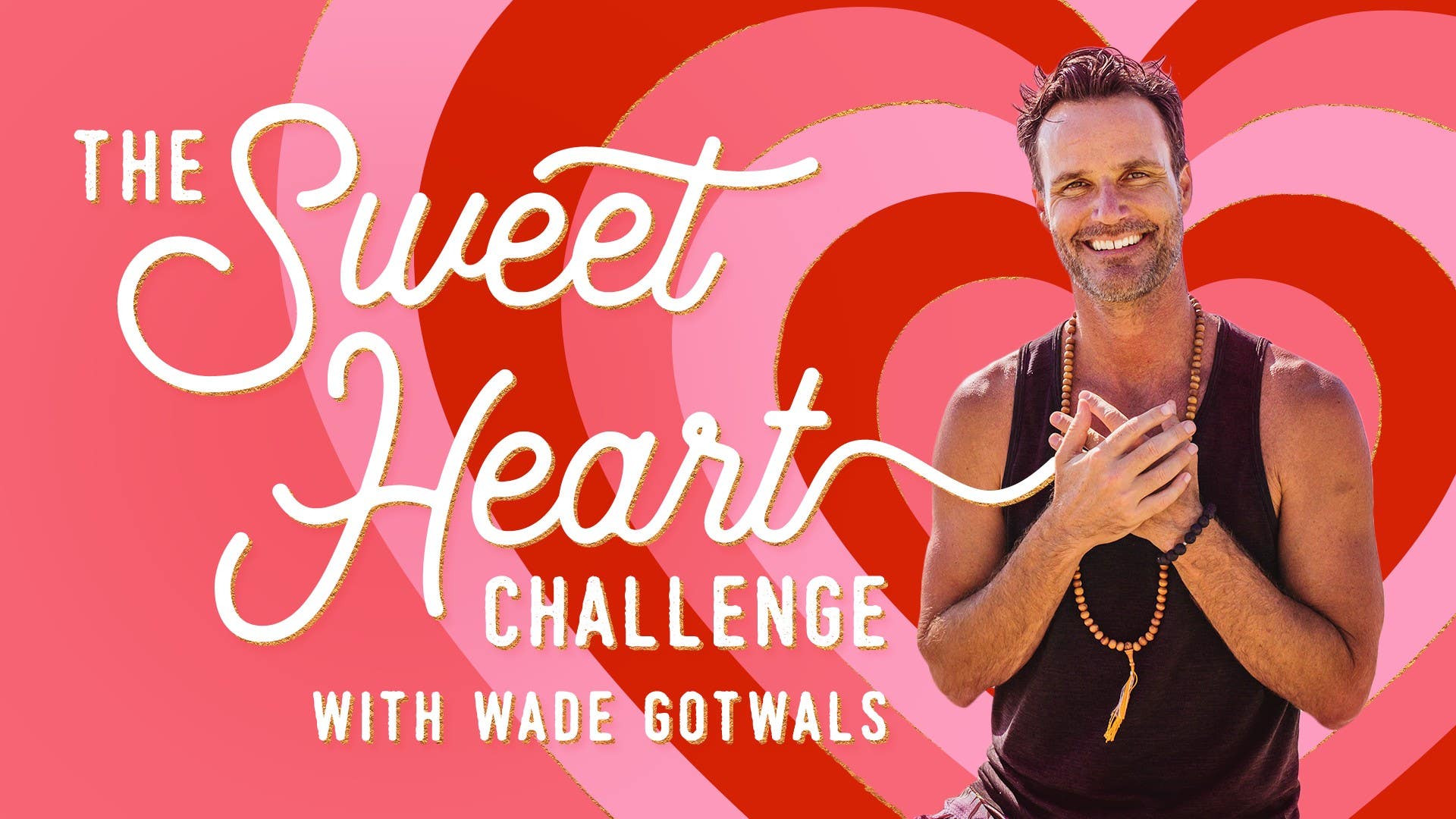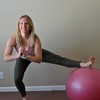Description
About This Video
Transcript
Read Full Transcript
Happy day, yogis! Welcome back. We are on day eight. Where is the time going? And appropriately enough we're going to be talking about change and impermanence today. But I'm curious how you went with yesterday's practice on unconditional love of the mother. Were you able to bring that into the rest of your day and try to see each being with that quality of unconditional love? It's a real challenge. But when we move into that space of unconditional love, we can pretty much deal with any other challenge that arises. Even this concept of impermanence, which is just a truth. Everything is in constant flux, change, birth, death. Even our cells in our body right now are changing. And when we start to flow more with this concept that everything's changing, the stagnant waters of the heart, you know, we get stuck in that idea of this is how it's going to be. I have control. Those waters start to move freely again when we start to, you know, open up to the concept of change. So with this idea, let's try to move into our practice together, this practice of impermanence with this fluidity, letting things just rise and fall and change without trying to put any blocks in front of us, just moving through it fluidly as we explore impermanence. Alright, so let's come into child's pose. You can move close to the back of your mat with your toes and take your knees a little bit wider than your hips. If you're tight or have any knee or ankle issues, you can sit on a block or you can roll up a blanket and put it right on top of the calf muscles behind the knees. And you should be able to find a nice sweet spot to relax into your child's pose. Journeying the palms forward so we can start to stretch the side body. You feel a nice lengthening the back body, the sacrum, the lower back and resting the forehead on the floor. Let's connect with the rise and fall of our breath, using the power of our inhalations to clear and purify our mind. Bring the breath all the way to the heart center and using the exhales to move out any busyness, any tension, physical, mental or emotional through the exhalations. Taking a moment to clear and purify, really be present for our practice today. We're gonna start to direct and invite the breath all the way down to the belly. So invite the breath to move a little deeper. See if you feel the breath pressing against the inner thighs as you let the belly really soften in the direction of the floor. And then take your time with the exhalations. Nice, slow, deep inhales all the way to the belly, maybe experiencing the breath in the side body and the back body. Enjoy a pause and take your time with the exhales. Give yourself three more rounds of these full belly breaths at your own pace. Enjoy that quiet in the mind. And then we'll keep the child's pose, but we'll slowly walk the palms over to the right so that we get a nice side stretch on the left side body. And then invite the breath to be slower, fuller and deeper on those inhalations. So you're creating more space around lungs, heart, intercostals. Instead of compromising the inhale, see if you can go big with the inhales. Finish off that last round and take your slow journey back to neutral child's pose and then start to walk your palms to the left. Hang out where you feel a little resistance and then breathe into that resistance. You might notice that the inhale feels a little compromised in this pose. See if you can breathe into that space, slower, fuller, deeper inhales. Good. Slowly walk your palms back to child's pose and then we'll journey up to our table and you might have to stretch out one leg at a time here and just press it back into the wall one leg at a time. As we move into our cat and cow tilts today, less of really focusing on the movements themselves and just being a little bit more intuitive and noticing where the pose begins and ends and how the breath is involved as you soften the belly, look up for your inhales and contract, dome the spine with your exhales. Start to invite a mind of curiosity just to start to notice the beginning, middle and end of the pose and see if you can slow it down a little bit.
Choreograph the movements with your breath. Good. We'll move into a neutral spine. We'll walk the fingertips forward and that same side bend that we took in our child's pose we're going to try in our down dog. So go ahead and tuck your toes under and give yourself a moment to just pedal one leg at a time straight and explore the hamstrings and calf muscles. Make sure you're actively putting weight into each finger so you're not sinking into the wrists. Your biceps are spiraling forward. The navel is drawing up to the spine and then we're going to keep the left leg bent and we're going to pivot both heels to the right. So your left heel will be right in front of your right toes. You should feel that side stretch in the left side body and go ahead and bend and straighten one leg at a time and take it for a little walk into those hamstrings and the IT bands here. That's good. Move forward to your plank pose. Pivot the toes. Let's lower the knees to the floor. Lengthen the forward as you bend the elbows and then replace the palms with your elbows for a nice easy sphinx pose. Inviting the ribs forward, rolling the shoulder blades back, internally rotating the quads. Good. And then walk the palms back. Give yourself about three breaths in your cobra pose or move back to the sphinx pose. Whatever feels right for the back today. Tuck the toes under, press back to your down dog. Once again, we'll just bend one leg at a time, pedaling it out. And then keep the right leg bent and pivot your heels to the left. Feel that nice side stretch on the right side body and breathe into that space, just like you did in your child's pose. And then explore bending one leg at a time. Good. Pivot your toes, move to your plank pose.
Option of lowering the knees for this one or keeping the knees off the floor and slowly lowering down. Moving right into our cobra up dog. Or if you're staying lower today, be kind to your lower back and stay in sphinx pose. Good. Tuck the toes under, press back to your down dog. We're gonna walk the hand slowly back towards the feet. Give yourself enough room from your heels to the wall so that you can softly shift your weight forward and backward. Let the muscles in the face, the jaw, the neck go. So go ahead and bend the knees and we'll keep the knees bent here and we'll come up to our chair pose. We'll bring the palms on top of the knees. And the nice thing about the wall here is that you can use the wall for your chair pose as you send the palms to the sky. And feel a little bit more supported here as you spiral the biceps towards the back wall, draw the navel up and back and fire up the quads.
Great. Give yourself two more breaths right here. One more and then we'll go ahead and slowly rise up. Good. Give yourself a little bit more space away from the wall. Give yourself about one step forward. We're going to go back into chair pose, not as supported this time. So as you exhale, keep the feet hip distance as you exhale, bend both knees. And as you inhale, sweep the palms to the sky. In this variation of chair pose, we're going to move into Arda Utkatasana, which is flat back chair. And we're going to interlace the hands behind the back. With this interlace, you start to move the wrists away from your seat and we're going to straighten the right leg. As you straighten the right leg, go ahead and move your wrists a little farther away from the seat. Keep the left leg bent, lengthen the spine as you inhale and softly roll the right rib cage to the sky as you exhale. Lengthen with the inhale and rotate with the exhale. Rest in your chair pose. Inhale the palms to the sky. So we're starting to fire up the legs a little bit, drawing a little heat, creating a little heat for the practice. Arda Utkatasana, flat back chair. Take the non-habitual interlace, the weird one, the weird index finger on top. Move the wrists away from the seat. So the shoulders and the hips are about the same height.
Keep the knees bent. Move the wrists away from the seat and then start to straighten your left leg. Right leg stays bent. Lengthen the spine with the inhale. Rotate with the exhale. Lengthen, create space for deeper rotation. Give yourself one more round. Rest in your chair pose. Good. And then take a nice soft forward fold.
You have the opportunity to walk your hands forward. Well, we did that Olympic Swimmers dive. A couple of practices ago. So if you're feeling it, reach the arms back. Keep your chin up. Inhale, cobra, up dog. And exhale. Lower all the way down. We're going to set up for sphinx pose, but I'd like you to keep your toes really close to the baseboards in your sphinx pose. Good. Squeeze the biceps towards each other and then roll the shoulder blades back and lengthen through the front body. So with our toes next to the baseboards, we have the opportunity to walk the wall if we want to make this a little bit more challenging. So tuck the toes under. And from here, lift your right foot off the wall. Right foot to the wall. You can stay here, press in with the right toes, or you can challenge yourself and extend the left arm forward.
Give yourself a couple of breaths here, knowing that the pose will end. You go back to that rest in sphinx pose. Go and lower down. Roll the shoulder blades back towards each other, lengthen the ribs, heart forward. Good. And then come back to your sphinx pose. Neutral shoulders over the elbows. Tuck the toes under. Forearm plank. This time we step the left toes into the wall. Actively push into the left toes. This will give you stability in case you want to walk the right fingertips forward or extend. Breathe into it. Try three more breaths. Enjoy the challenge. And then enjoy the ending of the challenge. Create that new shape. Cobra up dog. Come back to your child's pose, but bring your knees closer together for this variation. And then we'll grab a seat on our heels. Feel free to roll up a blanket and put it underneath your knees, between your knees and your calves, or sit on your block. Bring the palms together and bring the elbows together. We're going to work with a couple of field goal cat and cow tilts here. So as you exhale, draw the elbows in, curl the spine into that cat tilt. And then as you inhale, lift the elbows up, the height of your shoulders, separate, and squeeze the shoulder blades together. Exhale, draw it in. Slow with your breath. Inhale, lift, separate, and squeeze.
The heart is lifting to the sky. Take two more rounds. Follow the rhythm of your breath. Last one. And come into a neutral child's pose. We're going to walk the palms forward. And then we're going to try that knees, chest, and chin, bending the elbows and sliding forward. Cobra up dog. Let's try that one again. A little smoother. Maybe not even touching the floor with the chest and the chin this time. A little bend in the elbows out to three and nine o'clock. Hug them in, slide forward. Press back to your down dog.
So this is a little opportunity here to step the right foot into the wall and remember that fear challenge that you were working with before. If you want to send the left leg up to the sky, feel free. Lower the left leg to the floor and step the right foot to the front of your mat. Lower the left knee to the floor. And this is where I'm going to use a blanket underneath the left knee just to give it a little extra cushion because we're going to be here for a while. If you don't have a blanket, feel free to double up your mat on this one. We're going to go back to those same movements that we were working with before, the cat and cow feel goal tilts, really activating the core muscles.
So bring forearms together and palms together. Sink into the crescent lunge and then as you inhale, separate the elbows, lift the ribs and heart. Lift them to the sky so you're not crunching into the lower back. And then as you exhale, bring forearms, elbows towards each other, dome the spine, cat tilt to the spine. How deeply you go inside is really up to you. Find that sweet spot. And then as you inhale, lift and squeeze, flow with your breath. Give yourself one more round. And we'll pause and we'll meet with those feel goal arms, arms, squeezing the shoulder blades together, lifting the heart, lifting the ribs. Then we'll bring the right hand on top of the right thigh, left hand to the floor, lengthen the spine, press down with the right hand as leverage for your twist. Lengthen and rotate. If you want to move deeper into the pulse, tuck the left toes under, send the right palm to the sky.
Lower the right palm to the floor, tuck the toes under and move the blanket over to the side. We're going to take a little vinyasa, right leg to the sky. And oh, look, we have a wall here still. So if you want to send it up one more time, you've got your opportunity, create a little bit more heat in your flow, lower to down dog, plank, cobra up dog, send it back to your down dog, reconnect with the breath. Bend your left leg, inhale the left leg to the sky. Same opportunity, step it into the wall. If you're creating a little bit more heat for your practice, lower the right leg, step the left foot to the front of your mat. Use that blanket underneath your right knee as you come up to your crescent lunge. Right knee, right hip. If you want a softer experience, or sink into and open up the psoas for a little deeper experience. We'll bring palms and forms back together. Lift the elbows the height of the shoulders, inhale, separate and squeeze and lift the heart. Exhale, draw it in and curl the spine. Make sure you use your core muscles here as you take that cat tilt. Lengthening and lifting, maybe drawing that left knee forward for a deeper lunge and curling using the core muscles to support you as you fold in. Pause, feel the arms, lift the heart, squeeze the shoulder blades together, sink into the front thigh. Good.
Lower the left palm on top of the left thigh, right hand to the floor, lengthen the spine, press forward and down for a little leverage for your twist. Lengthen and rotate. If you want to feel a little bit more depth, tuck the right toes under and inhale the left palm to the sky. Breathe into wherever you're at. Notice the beginning, the middle and end of the pose and how you respond to all parts of it. Are there certain poses you want to end quicker than others? And can you just be okay with whatever's happening, right? Tuck the right toes under, left leg to the sky. Stay here or last opportunity to step it into the wall. Good. Lower down, take a little child's pose, reconnect with the breath. So from your child's pose, come on and grab a seat on your heels. We're going to face the wall. You can decide if you want to use this blanket under your knees or not, but we're going to turn and face the wall. I'm going to put the blanket to the side for right now and we're going to breathe about arms distance away from the wall. So from here, we're going to set up. I'm going to demo with the left arm so that you can see this experience here. We're going into a single arm dolphin. So where my left palm is, I'm going to place my left elbow. So my middle finger lines up with the elbow. For some of you it'll start to swing in or your elbow will start to swing out. See if you can resist that. My right arm is still in line with my left elbow, right elbow hugging in like I'm doing a push-up. My right leg is going to stay and I'm going to choose whether the left leg is going to stay or not as I back up my seat.
So if you're feeling resistance right here and that's enough resistance, stay here. If you want to feel more, shift your weight into your right leg and step the left leg back and press into, oh, into goodness, into sweetness. So we're going to back into that space of finding that perfect spot where we're finding, experiencing resistance, but we are enjoying the experience. So breathe into that space. It's really important to do these single arm dolphins because most of us have one shoulder with more range of motion than the other. So this gives us the opportunity to really sink into your shoulders individually. Slide your left leg back, shake out that left arm. You're going to feel that maybe tomorrow and then bring your palms the same height as your shoulders. Left arm stays, right elbow, line up middle finger with your right elbow and then just start to press into the wall with the left hand and start to back up your seat. This is the right resistance where you stay right here. If you want to feel more, shift your weight into your left leg and slide the left, the right leg back. You're pushing back with your right heel to add more resistance. You're pushing into the wall with your left hand to add more resistance.
Make sure you're breathing into that resistance. It's good resistance. It's something that you have that little balance of challenge, but you're able to breathe into it and you know you're creating more space. Good. And then go ahead and come back to center. We're going to spin back around and now that we've got both shoulders open equally, we're going to move into dolphin pose with the opportunity to walk the wall. So it's very similar to what we did in our handstands, walking the wall, but with our elbows on the floor. We're going to set up the same way, table pose, but you're going to bring your right and left forearm to the floor where your palms were. Squeeze the shoulder blades, squeeze the biceps, not the shoulder blades, squeeze the biceps towards each other. And with this little squeeze, you're going to activate the shoulders and you can tuck the toes under. If your hamstrings are a little tighter, feel free to move the elbows forward a little bit. Squeeze the biceps, tuck the toes under. So this is our dolphin pose. Exploring it a little bit by shifting the weight forward and backward will help you connect with your hamstrings and the space between the shoulder blades, deltoids, and the latissimus muscles, muscles of rotation. Bend your right leg and let's explore. Step the right foot into the wall. See if you can lift the left foot off the floor a little bit or a lot. Take the drishti forward and send the left leg to the sky. Just optional, you can keep the left toes hovering off the floor. Press actively down into your forearms and your palms. Be active with your left leg. Really lift it to the sky. Be active with the left leg. It helps you move out of sinking into those shoulders. Lower down nice and slow. Give yourself a little break in child's pose. So we're going to hold the second round a little bit longer so you can really get into the shoulders.
And if you started to feel a little bit more open when you're moving into the second round, you can use your block. You'd use your block right into this corner between thumb and index finger and use the block. Wrap the thumb and index finger around it as you move into that same dolphin pose. So we start in our table pose. Toes are just about touching the baseboards and then where our palms were is where our elbows go. Tuck the toes under, squeeze the biceps towards each other and this time we're going to step the left foot up the wall and press. Maybe the right toes come off the floor. Maybe that's all we're doing today. Just lifting, pressing down and forward with the forearms. Maybe you're feeling comfortable sending the right leg to the sky. Be very active with the right leg. Press forward and down into the forearms. Press under the index and thumb. Dristi is slightly forward. Don't look back towards your navel. Keep lifting and the pose will end. But we're going to stay here and feel that space where you want to come out of it and see if you can stay for two more breaths. That's when you really feel the pose. Slowly lower down. Child's pose. Good. Now we're going to come up and grab a seat. You can move your block to the side here.
We did a quad stretch a couple of practices ago where you were doing the quad stretch at the wall standing. I want to give you that opportunity if this one isn't working for your knee. It's a little bit more weight-bearing. We're going to put the blanket at the baseboards here. When we slide the right knee down, you'll know whether this is appropriate for you to do with your right knee on the floor or standing and exploring it that way. We're going to back up until my toes are touching. I'm going to slide my right shin up the wall. I'm just going to start to lower it down. Check and see how that pressure is on the top of the knee. This could be your spot to just start to press the seat back. Or if you're able to, replace your left knee with your left foot. This might be your spot right here. The pressing back into the wall is where you start to feel your resistance. If you're still comfortable here, come up to a nice low lunge. Instead of leaning forward on this one, we're going to get that front of the quad, quad and knee connection. We're actually trying to slide right inside of the right heel and press the seat back. Maybe even press the navel back towards the wall, shoulder blades. If you really just want to give up here, I want to surrender right here. Surrender into all three parts of this, the beginning, the middle and end of this pose. You can bring it into the field go cactus arms.
Good. We're going to keep the leg here and we're going to walk the palms forward. That front leg, we're going to move forward just a little bit more and we're going to move into a low lunge right here with the seat away from the wall. You can do this pose in the center of the mat without your leg up the wall, just the same opportunity. The idea is to lengthen the seat down as you lift the heart and you'll feel this really juicy psoas stretch right here. It's this big muscle that hinge that helps us move forward and backward. Most of the time, we're in these positions where we're moving forward, computers, cars. For this pose right here, if we stay here for a while, we might soften into and release some of that gripping in the psoas muscle. Remember, we're not going to be here forever. We can just settle into it, and enjoy the experience as long as it lasts, or attempt to enjoy the experience as long as it lasts. And we'll slowly come out. This is the best part.
So we'll release that right leg. If you want to shake it out a little bit, feel free to shake it out. And then we're going to shift our weight into the right leg and slide the left shin up the wall. Remember to take the opportunity of standing and taking your quad stretch. Same opportunity here, or if you're moving into the side deeper, press the seat back. Opportunity of replacing the right knee with the right foot. If you're not feeling any pressure here, keep backing up your seat. Listen to the pose. Listen to how your body responds to the pose.
You'll feel a change in the breath if you're going too deep into the pose. The foot's just outside of the glute as you press the seat back. Go back to the breath. And if you want to bring it into that cactus or feel the arms, just surrender into the pose. Be there. Whatever's happening, whatever's coming up for you.
Good. And then we'll bring the palms to the floor. And that same foot we're going to slide forward a couple of inches, maybe even a full six inches, so you can really sink into the psoas on that left side. This is a great spot to hang out if this is where you're feeling it. If you want to come up a little higher, you can use the support of your right hand, supporting the lower back, lengthening the seat down, zipping up, and lifting the front body to move deeper into the pose. Give yourself time in this one here. It's a big muscle, a big deep muscle. See where you're fighting in the pose and see where you can surrender into and relax into it. And then slowly come out. Oh, that's the best part. Shake out that left leg. Good. And we're going to bring this up to standing. We're going to bring it and pull it all together, the shoulder opener and the quad and psoas opener. So we're going to do a variation of nacho and jasmine that really opens up the shoulders. This is a good one. So we're in a stand. We're going to face the wall. I'm going to do this one with the right hand so you can see what happens with the left leg. Right hand is the height of your right shoulder. Replace your right hand with your right elbow. So we go back to that dolphin arm that we were working with before. Now use your left hand, press against the wall like you were doing previously, and just start to invite the seat to move back in space. You're going to feel the stretch underneath the right arm, shoulder where it connects to the torso. Breathe into that space.
Now go ahead and bend your standing leg, your right leg. This is going to be the supporting leg here. Lift your left leg off the floor, draw it up into the heel. Reach back for your shin and pull the heel in. From here we're going to move the knee away from the wall and just start to extend it back. Turn your left shoulder forward so you're still feeling this big shoulder stretch on the right side. If you want to move deeper into the pose, you can flip your palm and grab the big toe side of the foot, and then start to move the heel away from the seat. Go back to the breath. And slowly release out of it. Shake out that right arm. You'll feel it. But everything should start to open up through that right side body, through the sequence that we've been working on. Set yourself up. Left palm the height of your left shoulder. Replace your left palm with your left elbow. Right hand presses into the wall. Back up the feet a little bit so you start to feel the resistance here. The beautiful side stretch here. The left leg is going to be our standing leg so you can take a nice bend into the left leg. And then offer up that right leg. Draw the heel into the seat. Push into the wall so that you accentuate the back bend. Reach back with the right hand. Top of the foot. And draw the heel in for a little quad stretch. When you feel steady in the pose, start to move the heel away from your seat. If you feel like you'd like to go deeper into the pose, flip your palm, big toe side of the foot, and start to inhale the heel away from the seat. Take your time here. You've got the support of the wall. And then slowly release. If that one doesn't open your heart, nothing's going to open that heart. So we're going to bring it down and we're going to come into bridge pose. We're going to bring our toes towards the wall in bridge pose. So we're going to be facing the wall in our bridge pose. Come on back down to your seat.
In your bridge pose, give yourself about six to eight inches between your heels and your seat. And go ahead and lower down. We're going to take a very soft bridge pose for the first round. We're going to draw those elbows in right next to the ribs, pressing the triceps into the floor. And we start to invite that extension of the spine, the back bend of the spine, as we press the elbows into the floor. We keep that extension and we lift the seat off the floor and we slide one elbow in at a time. A little added press down into the toe pads will help you lift the heart and lift the hips. A little internal squeeze of the thighs, internal rotation will help you lift the legs a little bit higher. And then very slowly let your spine accommodate. Come down very slowly vertebrae by vertebrae. Take your time. Give yourself a moment to just relax here for a second. So we're going to set up for a variation of bridge pose using the wall. If you want to slide your seat closer to your heels and open up a little bit more in the pose, feel free to do that one. Same thing, pressing the forearms, triceps into the floor. And as you lift up this time, lift your right leg up. The height of your right knee is where that foot is going to press into the wall. And then as you push down into that right leg, the hips should lift.
You can stay here, you can support, or you can take the inner lace and squeeze those shoulder blades together. As you press into the wall, you'll start to feel the heart lifting here. Enjoy that space, enjoy the support of the wall, and enjoy your breath. Good. And we're going to slowly come down, rolling down one vertebrae at a time. If you need a rest here, take the rest, but we're going for it. Straight into the second side, right foot presses into the floor, triceps down, both heels press, lift the hips, step the left foot into the wall, the height of the knee. And as you press, your hips will start to lift, giving you a little deeper back bend here, supporting the floor, sacrum, or taking the inner lace. Go and lower it down, vertebrae by vertebrae, nice and slow. Good. Give yourself a little bit wider stance than your mat. Take the arms out to the side of like wings and just clear the lower back with some windshield wipers. Choose a side and roll over to that side. Give yourself a moment here and fetal pose. And then use that palm to help yourself press up.
We're going to take a nice supported meditation against the wall. I like to sit on a blanket that gives me a little bit more height and a little bit more support. So you can bring your blanket to the wall. Give yourself a couple of inches away from the wall so that abundance can slide next to the wall. Choose a comfortable cross-legged seat. If you need to prop yourself up more, go ahead and prop yourself up more. Enjoy the support of the wall. The shoulder blades drop away from the ears. Let the chin drop an inch or two towards the chest and lift the heart to meet it. Relax the muscles in the face and the jaw. Enjoy the rise and follow the breath without controlling it. And just be the witness to the breath like you're the observer. And notice when the inhale finishes, notice the pauses, the spaces in between.
And when the exhale begins, we're always in this beautiful dance of change. And as we start to flow with that river of impermanence, we start to really move into the current of the heart. We flow gracefully with life. So you can start to even feel that your body feels a little bit more fluid and less rigid. As you breathe in and then out, you might feel that that energetic body is expanding beyond the borders of the physical body with inhale and hugging back towards the heart with the exhale. And take your attention down to that heart space.
A reminder that this is the unchanging space that we reside in and should give us confidence to embrace all other changes and impermanence, knowing we're always one connected to this space of love. Take your time. As you open the eyes, let the eyes be heavy, relaxed as you come out of your meditation. And see if you can carry the qualities of this practice with you for the rest of the day and keep cultivating this idea that everything is in this state of flux, this constant fluid movement of change. And when we let go of those attachments that we have and that control that we have, we can really appreciate each moment that unfolds before us and we can be really present for ourselves and for each person that we can connect with. Thanks for connecting with me today. Namaste. I'll see you on the mat tomorrow.
The Sweet Heart Challenge
Comments
You need to be a subscriber to post a comment.
Please Log In or Create an Account to start your free trial.






















